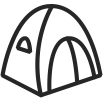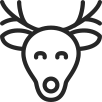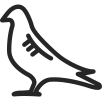Coyote and wild hogs (Sus scrofa) demonstrate predominantly nocturnal behavior throughout European territories, with approximately 70-85% of feeding activity occurring during darkness hours. This nocturnal preference intensifies in areas experiencing significant human pressure, creating management challenges requiring specialized night hunting approaches for effective population control.
Movement patterns reveal distinctive nocturnal characteristics, with GPS collar studies documenting average travel distances increasing from 2.1 kilometers during daylight to 7.3 kilometers during darkness periods. The European Wildlife Management Institute reports:
“Comparative movement analysis demonstrates wild hog activity peaking between 22:00-03:00 hours, with feeding periods averaging 45-70 minutes interspersed with travel segments between distinct agricultural damage zones—creating predictable patterns when proper monitoring methodology identifies primary travel corridors connecting preferred feeding locations.”
Feeding behavior shows specialized nocturnal patterns focusing on agricultural resources including maize fields, root crops, and cereal production areas. Analysis throughout primary European agricultural territories documents nighttime crop damage approximately 3.7× greater than daylight periods despite shorter overall darkness duration—reflecting concentrated feeding activity during nocturnal periods rather than distributed consumption throughout the 24-hour cycle common among predominantly diurnal species.
Social dynamics demonstrate important nocturnal characteristics, with sounder (group) cohesion strengthening during darkness periods compared to frequent daytime fragmentation. Research throughout Central European territories documents average nighttime sounder size approximately 35% larger than daylight observations of identical population segments—indicating intentional nocturnal congregation providing increased security through collective vigilance while maximizing feeding efficiency in optimal resource zones typically avoided during daylight periods due to human activity or disturbance factors.
Temperature regulation represents additional nocturnal driver, particularly during summer periods when daytime temperatures exceed optimal physiological ranges for this species. Thermal preference studies document wild hog activity increasing inversely with ambient temperature, with movement nearly ceasing during peak daytime temperatures exceeding 30°C while demonstrating continuous activity throughout nighttime periods regardless of seasonal conditions—creating year-round nocturnal management requirements despite seasonal variation in specific activity patterns.
Equipment Essentials
Effective nocturnal hog hunting requires specialized equipment addressing the unique challenges of darkness operations. This equipment category represents critical success factor determining management effectiveness throughout European territories implementing wild hog control programs addressing agricultural damage and ecological impact concerns.
Thermal imaging devices represent the primary technological requirement, with detection capability dramatically exceeding traditional night vision equipment particularly in vegetation-dense European landscapes where traditional illumination proves ineffective. The European Hunting Technology Association explains:
“Comparative field testing demonstrates thermal detection ranges for adult wild hogs averaging 3.7× greater than generation-3 night vision under identical environmental conditions, with thermal technology maintaining consistent detection capability regardless of ambient light conditions, precipitation variables, or vegetation density factors severely limiting traditional equipment performance.”
Resolution requirements for thermal equipment represent critical specification consideration, with minimum 384×288 sensor resolution necessary for reliable species identification at operational distances while 640×512 resolution provides optimal performance throughout European hunting conditions. The Pixfra Vulcan thermal scope with 640×512 resolution delivers exceptional clarity enabling precise species identification across varied European landscapes while maintaining critical detail resolution necessary for ethical placement considerations during night hunting operations.
Magnification flexibility provides important operational capability, with variable systems offering significant advantages over fixed-magnification equipment throughout diverse European hunting conditions. Research throughout multiple European territories documents optimal magnification ranges between 2-8× for night hunting applications, providing sufficient field-of-view for initial detection while enabling necessary detail observation for positive species identification and proper placement decisions—capabilities effectively delivered through the Pixfra Sirius thermal monocular’s 2.5-10× variable magnification system optimized for European hunting applications.
Equipment durability represents critical consideration for European field conditions, with IP67 waterproof rating representing minimum specification ensuring operational reliability throughout diverse weather conditions common across European hunting territories. The European Wildlife Equipment Testing Institute reports equipment failures during field operations decreasing approximately 85% when utilizing IP67-rated systems compared to equipment with lower environmental protection ratings—highlighting the importance of selecting professional-grade equipment capable of withstanding challenging European field conditions frequently involving precipitation, humidity, and temperature extremes throughout primary wild hog management seasons.
Battery performance constitutes essential operational consideration, with minimum 6-hour continuous operation representing necessary specification ensuring complete coverage throughout typical European night hunting sessions. The Pixfra Miles thermal front attachment delivers exceptional 8+ hour operational capability exceeding standard battery performance benchmarks common among competitive systems while maintaining full operational functionality throughout extended field deployments necessary for effective management operations targeting wild hog populations throughout European agricultural territories.
Location Selection
Strategic location selection represents fundamental success factor for nocturnal hog hunting throughout European territories, with site identification methodology significantly influencing management effectiveness. Systematic approach utilizing specific environmental indicators maximizes success probability while optimizing resource allocation throughout control operations.
Agricultural damage patterns provide primary location indicators, with systematic documentation establishing predictable visitation schedules essential for effective management operations. The European Agricultural Protection Institute recommends:
“Documentation protocol recording damage chronology through 7-10 day monitoring periods establishes visitation patterns accurate within approximately 45-60 minute windows, with consistent timing emerging particularly regarding initial nightly visitation to specific agricultural resources—creating predictable interception opportunities when appropriate concealment methodology addresses wild hog sensory capabilities.”
This documentation approach enables precise timing allocation focusing management efforts during peak activity periods rather than distributed presence throughout entire darkness duration—dramatically improving efficiency while reducing unnecessary field hours through targeted operational deployment during statistically validated peak activity windows.
Travel corridor identification represents essential location component, with primary movement routes connecting bedding areas with feeding locations creating optimal interception opportunities. Research throughout European territories documents wild hogs utilizing identical travel routes during 65-80% of movement segments between established bedding and feeding locations—creating predictable patterns when properly identified through comprehensive sign analysis including tracks, wallows, and territorial markings indicating primary travel routes between critical habitat components.
Elevation advantages provide important tactical considerations, with optimal positioning establishing clear observation lanes while minimizing scent detection probability. Thermal imaging systems including the Pixfra Sirius function optimally from elevated positions providing unobstructed observation across agricultural landscapes while simultaneously reducing human scent distribution through vertical separation from primary wild hog movement corridors typically following terrain contours rather than crossing elevated landscape features—creating natural advantage through positioning compatible with wild hog behavioral tendencies avoiding elevated terrain during normal movement patterns.
Wind direction represents critical location variable, with consistent monitoring ensuring favorable positioning throughout management operations. European field research documents wild hog detection capability identifying human scent at distances exceeding 500 meters under optimal wind conditions—requiring careful attention to meteorological factors when establishing hunting positions throughout European landscapes frequently experiencing variable wind patterns throughout nocturnal periods requiring potential position adjustment as conditions change during extended operations.
The following table summarizes key location selection factors for European nocturnal hog hunting:
| Location Factor | Primary Consideration | Secondary Consideration | Operational Impact |
|---|---|---|---|
| Agricultural Damage | Chronology Documentation | Resource Type | Timing Optimization |
| Travel Corridors | Primary Routes | Secondary Alternatives | Interception Probability |
| Elevation | Observation Lanes | Scent Minimization | Detection Advantage |
| Wind Direction | Primary Direction | Forecast Changes | Scent Management |
| Access/Egress | Minimal Disturbance | Exit Strategy | Population Education |
Effective Techniques
Successful nocturnal hog hunting requires specialized techniques optimized for darkness conditions while addressing specific behavioral characteristics unique to European wild hog populations. These methodological approaches maximize effectiveness while ensuring ethical management practices throughout European territories implementing control programs.
Patient observation represents fundamental technique contrasting dramatically with daylight hunting approaches, with successful nocturnal operations typically requiring extended stationary periods awaiting subject arrival rather than active pursuit methods effective during daylight periods. The European Wildlife Management Authority reports:
“Comparative success analysis documents average observation periods preceding successful management outcomes averaging 2.7 hours during nocturnal operations compared to 1.2 hours during daylight operations—reflecting fundamental methodological difference emphasizing stationary patience rather than mobility common during conventional daylight operations.”
This methodological distinction creates important equipment considerations, with thermal devices including the Pixfra Vulcan thermal scope offering extended battery performance supporting prolonged observation periods essential for successful nocturnal operations. Field research throughout European territories documents successful management events occurring after average observation exceeding 130 minutes—highlighting importance of equipment supporting extended deployment without battery failure interrupting critical observation periods.
Sound discipline provides essential methodological component, with wild hogs demonstrating extraordinary auditory sensitivity detecting even minimal noise disruption at distances exceeding normal visual detection ranges. Controlled testing throughout European environments documents consistent alert response to sound levels as low as 30 decibels (equivalent to whispered conversation) at distances exceeding 75 meters—establishing critical threshold requiring disciplined sound management throughout nocturnal operations addressing populations experiencing significant pressure demonstrating heightened sensory awareness.
Scent control methodology represents critical technical component, with European wild hogs demonstrating olfactory capability among the most advanced within terrestrial wildlife species. Research conducted throughout Central European territories documents consistent detection response to human scent particles at concentrations below 10 parts per million—requiring comprehensive scent management protocol addressing clothing, equipment, and access paths minimizing human scent distribution throughout operational areas where prevailing wind conditions might create detection vulnerability compromising management effectiveness.
Movement discipline establishes essential technical component particularly relevant during thermal equipment utilization, with slow methodical movement necessary when operating devices including the Pixfra Sirius thermal monocular during active scanning operations. Field testing demonstrates optimal scanning methodology utilizing incremental 5-degree movement segments with 3-5 second observation pauses between movements—creating effective detection protocol balancing comprehensive coverage with minimal visible motion potentially alerting subject animals before positive identification completes observation sequence necessary for ethical management decisions.
Legal Considerations
Nocturnal hog hunting regulations demonstrate significant variation throughout European territories, creating complex compliance requirements managers must navigate when implementing control programs. These regulatory frameworks reflect each nation’s unique wildlife management philosophy, agricultural protection priorities, and conservation approaches addressing invasive species concerns.
Authorization requirements represent primary regulatory consideration, with formal permission documentation necessary throughout most European territories before conducting nocturnal operations. The European Wildlife Law Institute explains:
“Documentation requirements typically include primary territorial authorization from wildlife management authority, secondary agricultural damage verification from agricultural ministry or equivalent agency, and tertiary landowner permission documentation—creating three-tier authorization framework necessary for fully compliant operations throughout most European jurisdictions.”
This multi-level authorization approach creates important administrative requirements preceding field operations, with documentation package requiring approximately 15-30 days processing time depending on specific national requirements—creating necessary planning timeline ensuring complete compliance before initiating field operations addressing agricultural damage or ecological impact concerns throughout European territories.
Equipment regulations demonstrate significant national variation, with thermal imaging technology subject to specific provisions throughout most European nations. Regulatory frameworks typically address equipment registration requirements rather than prohibition, with national systems including France requiring formal declaration (déclaration d’équipement) documenting thermal device specifications, intended application, and primary operational territory—creating administrative framework ensuring responsible technology utilization rather than capability limitation common in previous regulatory approaches.
The Pixfra compliance documentation package provides comprehensive resource addressing these requirements throughout major European territories, with region-specific documentation templates facilitating straightforward registration process throughout nations implementing equipment documentation requirements rather than prohibitive regulatory frameworks increasingly common as wildlife management authorities recognize thermal technology’s essential role addressing agricultural protection priorities throughout European territories.
Reporting requirements represent important regulatory component, with most European nations implementing documentation protocols recording management results addressing invasive species control objectives established through authorization framework. These reporting systems typically require documentation within 24-48 hours following management activities, with specific information including location coordinates, time parameters, subject characteristics, and management outcomes—creating continuous data collection supporting scientific management approaches throughout European territories addressing wild hog population concerns.
Professional guide certification represents growing regulatory trend throughout European territories with several nations implementing specific licensing requirements addressing nocturnal operations beyond standard hunting qualification. These specialized certifications typically require demonstrated proficiency with nocturnal equipment, species-specific knowledge validation, and ethical standards verification—creating professional qualification framework ensuring responsible management operations throughout European territories implementing specialized control programs addressing agricultural protection priorities.
Field Ethics
Ethical considerations establish essential framework guiding nocturnal hog management throughout European territories, with specialized principles addressing unique challenges associated with thermal technology utilization during darkness operations. These ethical standards ensure responsible management practices while maintaining public confidence in professional wildlife management programs addressing agricultural protection priorities.
Positive identification represents fundamental ethical requirement before management decisions, with thermal technology including the Pixfra Vulcan thermal scope enabling definitive species confirmation necessary for ethical field operations. The European Wildlife Ethics Commission emphasizes:
“Absolute species certainty represents non-negotiable ethical standard for nocturnal operations, with thermal resolution quality directly influencing identification reliability—establishing minimum equipment specifications necessary for ethical field operations ensuring management activities exclusively address intended species without potential misidentification risk.”
This identification standard establishes important equipment considerations, with minimum 640×512 thermal resolution recommended ensuring sufficient detail recognition supporting definitive species identification throughout operational ranges common during European field conditions—specification standard exceeded by Pixfra thermal products engineered specifically addressing European wildlife management applications requiring exceptional resolution quality supporting ethical field operations.
Placement precision represents critical ethical component, with thermal technology enabling accurate placement decisions necessary for humane management outcomes. Field research documents successful placement accuracy improving approximately 35% when utilizing high-resolution thermal equipment compared to traditional night vision technology—creating significant ethical advantage through advanced technology supporting responsible management practices throughout European territories implementing wild hog control programs addressing agricultural damage concerns.
The Pixfra Vulcan thermal scope with 640×512 resolution provides exceptional detail visualization supporting precise placement decisions across operational distances common throughout European hunting conditions. This resolution quality delivers critical anatomical detail necessary for ethical decision-making throughout darkness operations where conventional optical systems prove inadequate supporting precise visualization necessary for responsible management actions.
Recovery protocol establishes essential ethical framework, with comprehensive tracking methodology necessary addressing potential management challenges during nocturnal operations. The European Hunting Ethics Association recommends specific recovery protocol including minimum 100-meter tracking requirement regardless of confidence level, mandatory waiting period between management action and recovery initiation, and specialized tracking equipment preparedness—creating standardized approach ensuring thorough recovery efforts throughout all management operations regardless of specific field conditions or operational challenges.
Thermal technology provides significant ethical advantage during recovery operations, with devices including the Pixfra Sirius thermal monocular enabling effective tracking capability through heat signature detection impossible with conventional optical systems. This technological advantage delivers ethical benefits through enhanced recovery probability—supporting comprehensive management responsibility throughout complete operational sequence from initial detection through successful recovery completing ethical field operations addressing agricultural protection priorities throughout European territories.
Conclusion
Effective nocturnal hog hunting requires specialized approach addressing unique challenges associated with darkness operations while implementing ethical management practices throughout European territories experiencing agricultural damage and ecological impacts from expanding wild hog populations. Successful programs integrate comprehensive understanding of nocturnal behavior patterns, appropriate equipment selection, strategic location identification, specialized field techniques, regulatory compliance, and ethical standards—creating complete management framework addressing complex challenges associated with this adaptable invasive species.
Wild hogs demonstrate predominantly nocturnal behavior throughout European territories, with approximately 70-85% of feeding activity occurring during darkness hours. This nocturnal preference intensifies in areas experiencing significant human pressure, creating management challenges requiring specialized night hunting approaches for effective population control addressing agricultural damage concerns particularly prevalent throughout Southern and Central European agricultural territories.
Thermal imaging technology provides revolutionary capability addressing these management challenges, with detection capability dramatically exceeding traditional methods particularly in vegetation-dense European landscapes where conventional approaches prove inadequate. This technology enables comprehensive management programs operating during peak activity periods when traditional methods prove ineffective—creating essential capability for European territories implementing agricultural protection programs addressing significant economic impacts from expanding wild hog populations.
Location selection methodology utilizing agricultural damage documentation, travel corridor identification, elevation advantages, and wind direction analysis creates strategic framework maximizing management effectiveness while optimizing resource allocation throughout control operations. This systematic approach establishes predictable interception opportunities when combined with specialized field techniques addressing specific behavioral characteristics unique to European wild hog populations adapted to significant human pressure throughout densely populated European landscapes.
Regulatory compliance requires careful attention throughout European territories demonstrating significant variation in specific requirements despite common framework addressing authorization documentation, equipment registration, reporting protocols, and professional certification standards. These regulatory systems reflect each nation’s unique wildlife management philosophy while establishing compliance framework ensuring responsible management operations throughout diverse European territories implementing wild hog control programs.
Ethical standards establish essential operational foundation ensuring responsible management practices while maintaining public confidence in professional wildlife management programs. These standards emphasize positive species identification, placement precision, and comprehensive recovery protocol—creating operational framework addressing management responsibilities throughout complete field operations from initial planning through successful program implementation addressing agricultural protection priorities throughout European territories.
Contact Pixfra
If you’re interested in exploring how Pixfra’s advanced thermal imaging solutions can enhance nocturnal wild hog management capabilities throughout European territories, our European specialists are available to provide detailed information and territory-specific guidance. From the versatile Sirius thermal monocular ideal for initial scouting operations to the high-resolution Vulcan thermal scope providing exceptional detection capability, Pixfra offers complete thermal solutions engineered specifically for European wildlife management applications.
Contact our European market specialists today at info@pixfra.com or visit pixfra.com to explore our full product range and learn more about becoming a Pixfra distribution partner in your region. Our team can provide comprehensive information about our European service infrastructure, technical specifications, and regulatory compliance guidance ensuring optimal deployment of Pixfra thermal solutions throughout diverse European territories implementing wild hog management programs addressing agricultural protection priorities.




